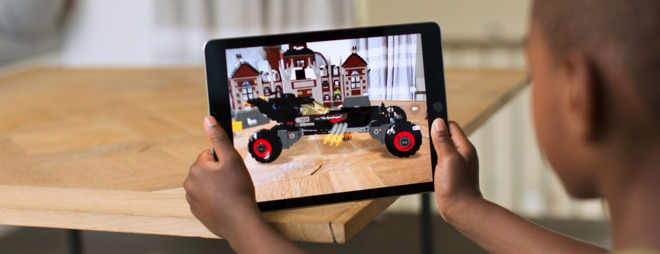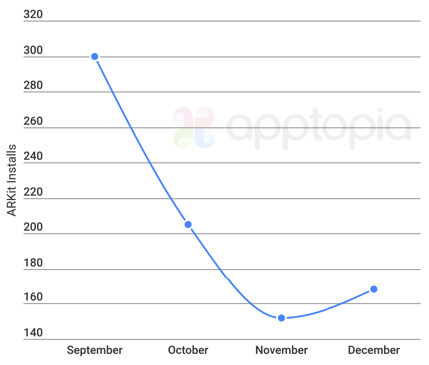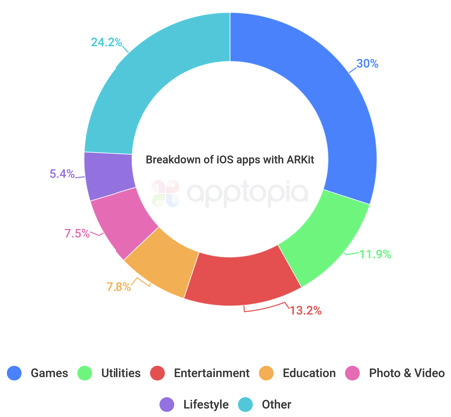Developer adoption of Apple's ARKit tepid after iOS 11 launch, data suggests
Less than 1,000 apps on the App Store support Apple's augmented reality tools, and the number of apps adopting ARKit has slowed since September, a new survey has found.

The data was released on Wednesday by app market intelligence firm Apptopia, which found that the number of new apps with ARKit tools integrated fell sharply after debuting in September. The number hit a low in November before rebounding slightly in December, but still remains behind the adoption rate seen in October.
The data suggests that while some developers were keen to embrace ARKit at launch, interest in the new capabilities in iOS 11 has softened among app releases and updates.

In all, about 300 apps with ARKit were said to have debuted on the App Store in September, around the launch of iOS 11. The number fell to just over 200 in October, before approaching 150 in November. According to Apptopia, it rebounded to around 170 in December.
To date, in all, Apptopia says there are less than 1,000 apps with ARKit capabilities, of more than 3 million downloads available on the App Store.
Its data found that most -- 30 percent -- of ARKit apps are games. The next most popular app category was entertainment at 13.2 percent, followed by utilities with 11.9 percent. A large number of apps fell under an undefined "other" category, accounting for 24.2 percent of options.
Remaining uses are education (7.8 percent), photo and video (7.5 percent), and lifestyle (5.4 percent).

With this fall's launch of ARKit, and comments from Apple Chief Executive Tim Cook extolling the potential of the technology, the company's bullish outlook on augmented reality is well known. Cook said in late October that the iPhone maker is focused on making the customer experience with augmented reality second to none, trusting that revenue and profits will follow as technology and apps improve.
"I view AR as profound," Cook said. "Not today, not the app you'll see on the App Store today, but what it will be, what it can be. I think it's profound, and I think Apple is in a really unique position to lead in this area."

The data was released on Wednesday by app market intelligence firm Apptopia, which found that the number of new apps with ARKit tools integrated fell sharply after debuting in September. The number hit a low in November before rebounding slightly in December, but still remains behind the adoption rate seen in October.
The data suggests that while some developers were keen to embrace ARKit at launch, interest in the new capabilities in iOS 11 has softened among app releases and updates.

In all, about 300 apps with ARKit were said to have debuted on the App Store in September, around the launch of iOS 11. The number fell to just over 200 in October, before approaching 150 in November. According to Apptopia, it rebounded to around 170 in December.
To date, in all, Apptopia says there are less than 1,000 apps with ARKit capabilities, of more than 3 million downloads available on the App Store.
Its data found that most -- 30 percent -- of ARKit apps are games. The next most popular app category was entertainment at 13.2 percent, followed by utilities with 11.9 percent. A large number of apps fell under an undefined "other" category, accounting for 24.2 percent of options.
Remaining uses are education (7.8 percent), photo and video (7.5 percent), and lifestyle (5.4 percent).

With this fall's launch of ARKit, and comments from Apple Chief Executive Tim Cook extolling the potential of the technology, the company's bullish outlook on augmented reality is well known. Cook said in late October that the iPhone maker is focused on making the customer experience with augmented reality second to none, trusting that revenue and profits will follow as technology and apps improve.
"I view AR as profound," Cook said. "Not today, not the app you'll see on the App Store today, but what it will be, what it can be. I think it's profound, and I think Apple is in a really unique position to lead in this area."


Comments
There was an iOS AR application called Layar (sp?) as long back as 6 years ago. It was actually pretty nifty: you'd hold up your phone at a street corner and it would point out where different shops/restaurants were in a distance (it might have even drawn arrows for directions - can't remember). While pretty useful, you got tired pretty quickly holding up the phone while navigating to the points of interest.
Once glasses debut, there will be tons of apps using ARKit - guaranteed. The distribution of ARKit now was just to whet developer's appetites.
I’ve said this before, while the tech is cool there’s a limited usefulness factor. All the games demoed “on” tables could be done just the same without having to look like it’s happening on a table. There’s no reason I have to be required to use the iPhone camera to pan around and zoom in or out of game play. That can happen just on the screen, no need for “AR”.
Smae art goes for that virtual tour of Apple Park. There is no reason Apple couldn’t let me download an app at home that lets me do all the same things without having to make a trip to Cupertino and point my camera at their model.
At this point it’s all a bunch of hype. As already mentioned, the useful stuff will likely work with HUD or glasses. The stuff that’s useful on the iPhone has mostly been around for years without ARKit.
If I can have a measuring tape app that works well like what shown on Twitter I'd be happy.
Apple's building for the future, 1000 apps is still a 1000 more than the competition and Apple can find out what works or not with that and correct.
They'll add more and more features to ARkit until someone produces some app that does hit the spot.
Fist you provide the canvas (they you provide the tools) ARKit, and then you provide the incentive to use this
I'm surprised they even found 1000 apps under any category in the App Store!
I'm not even sure how to look for apps under a category after the Top 200 Paid and Free apps.
This is a re-run of AppleTV - Cook said the future is Apps, he was wrong, now they’re scrambling to fold services in to the TV App which should have been mandatory from tvOS release.
No Apple smash-hit was ever driven by 3rd party software even iPhone was released with 1st party only.
if you wait till you release that product it is probably too late.
théy’ll likely add to the capability of the kit integrating the sensors used by Face ID and even more by June
btw AppleTV was sold out during the last 3 months so don’ know wtf uou are talking about
This tech was developed by Prime Sense who pioneered the Microsoft Xbox Kinect and was later acquired by Apple.
This 3D sensing precedes Apple ARKit. It uses a PrimeSense camera (similar to FaceID) attached to the rear camera on an iPad.
You can buy the camera for $350 and map rooms of a house (or business) and convert them into 3D CAD models. The mapping process is just walking around and pointing the iPad to virtually Paint* surfaces -- similar to paint with a virtual roller.
Adoption can take time and suddenly feel inevitable. In the late 1970s, I worked with a technology described as an invention looking for an application. Today, it is one cornerstone of everyday life, even found in the iPhone X. Any ideas what it might be?
It just doesn't serve much of a purpose beyond the initial curiosity.
**In other words, until it's drop-dead easy to use and there are few, if any physical barriers to interactions.